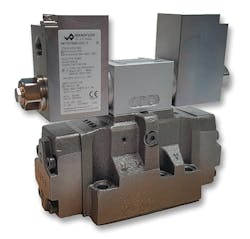Wandfluh AG, Frutigen, Switzerland, recently redesigned its entire line of NG10 hydraulic spool valves. The valves are based on a cast-body design, which is used for both direct- and pilot-operated valves. All valves in the range are capable of system pressures to 350 bar (5,000 psi) and some can operate at levels to 420 bar (6,000 psi).
Emphasis was placed on the symmetrical design of the valve. As a result, valves exhibit the same flow and pressure characteristics in both operating directions.
Direct-operated valves can control flows to 160 l/min (42 gpm) at a very low pressure drop (∆P). A soft-shift spool valve has been developed to reduce pressure shocks in sensitive systems. Valves can be optimized to a particular application by adjusting damping orifices individually.
Proportional versions offer low hysteresis for flows to 100 l/min (26 gpm) through flow simulation during design and flow optimization. Flow forces in the valve are kept low, flow rate improves at higher pressures.
A superimposed dither signal combined with a pulse-width-modulation (PWM) power amplifier provides high-response control. In addition, closed-loop control circuits can be integrated through fieldbus interfaces with machine control systems.
Pilot-operated valves, designed for compact installation, are pilot-operated by an NG4 spool valve. The result is reduced installation space and solenoids operating with low power draw. For example, solenoid power consumption has been reduced from about 30 W to 20 W for size NG6 switching valves. Maximum flow capacity at low pressure drop is 160 l/min (43 gpm). Weighing less than 4 kg (9 lb), the pilot-operated valve is lighter than the direct-operated NG10 valves.
The pilot-operated proportional valve is fitted with an NG4 mini pressure-control valve, one of the most compact available. The pilot control builds pressure to 40 bar (580 psi) to control the main valve up to 200 l/min (53 gpm). Users choose between external or internal pressure control within the valve.
Valves are fitted with exchangeable slip-on coils, which are available with different types of connectors, electrical power, and surface treatments. All are available with special design features, such as explosion protection, increased corrosion resistance, switching position monitoring, and operation in low temperatures.
Explosion-proof valves—the pilot control of the explosion-proof version uses Wandfluh’s NG4 mini valve technology, a modular system providing the entire NG10 range with the same performance as valves without explosion protection. Explosion-proof valves are often used in applications with low ambient temperatures. This means that versions of the NG10 explosion protection valves can be built for temperatures as low as −40°C.
The NG10 range also includes explosion-proof proportional valves. which can be used in applications with high flow rates, high operating pressures, and tight control.
For more information, call Wandfluh of America Inc. at (847) 566-5700, e-mail, or visit the company's website.



